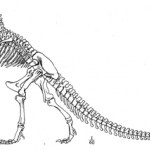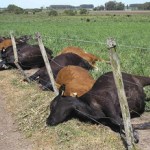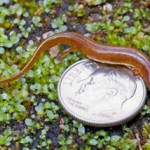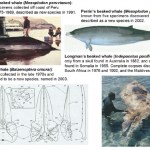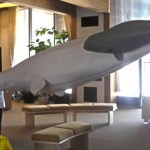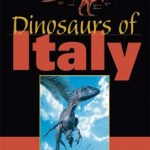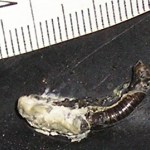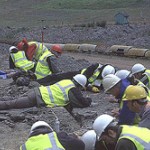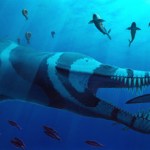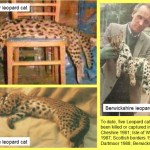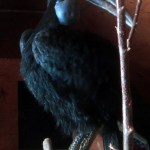A little while ago, news of a new paper by Devon Quick and John Ruben, both of Oregon State University, appeared on the newswires. It got its fair share of publicity.
Entitled 'Cardio-pulmonary anatomy in theropod dinosaurs: implications from extant archosaurs', the paper (Quick & Ruben 2009) purports to show that modern birds are fundamentally different from non-avian dinosaurs in terms of abdominal soft-tissue morphology, ergo birds cannot be modified dinosaurs. In slightly more detail, the paper asserts that a specialised 'femoral-thigh complex', combined with a synsacrum and…

You don't hear much about dromomerycids these days, it's always protoceratids hogging all the limelight. Here's one of the more obscure forms, the derived cranioceratin dromomerycine Procranioceras skinneri from the Miocene of the USA (originally named as a member of the speciose genus Cranioceras).
All dromomerycids are North American and they were mostly a Miocene event, petering out after the Middle Miocene and disappearing during the Early Pliocene (Janis & Manning 1998, Semprebon et al. 2004). They resembled various bovids and deer in proportions and probably lifestyle: some seem to…
A few posts ago the subject of giraffes and lightning came up in the comments (go here, and scroll down to comments 7, 9 and 10).
Thanks to an aborted book project that I've mentioned once or twice (I try not to talk about it too much, it still hurts), I have voluminous files on accidental or surprising deaths. I said I have something on death by lightning and - here - I deliver. It's not much, but then, that's not much of a surprise is it?
Lightning represents a significant hazard in the natural world and animals large and small may be killed during storms. The death of elephants following…
I have to say I really hate it when I see a blog post with an interesting title that concerns a complicated subject, only to find - on going to all that trouble of moving my fingers, clicking on the link, and waiting all of three or so seconds for the page to load - that the author has played the dumbass, and has instead reeled you in with a whole one line of text, or a picture, or something equally lame. Yes, I really, really hate that.
On an unrelated subject, do books really have to be so ~ucking expensive? I mean, seriously, who sets the prices? I'm going through a phase of buying…
Some time during the last several hours (while I was asleep), Tet Zoo reached the three million hits mark. Yes, three million hits in two years (Tet Zoo ver 2 was launched on Jan 31st 2007). A noble achievement, I'm sure you'll agree. Due to workload and assorted other commitments, I still don't have anything major new to post (how the hell do the more prolific bloggers do it?), though there was the new salamander thing yesterday - knocked up very quickly on the spur of the moment - and I've also just produced a new SV-POW! article. Inspired by a comment Nathan Myers left here recently…
The naming of new amphibian species is a fairly routine thing. This doesn't mean that - despite the global amphibian crisis - amphibians are actually ok and that we can stop worrying; it means that we haven't been paying enough attention, and indeed many of the species that are being named anew are endangered, or threatened, or with tiny ranges.
The current edition of Journal of Zoology includes the description of a new plethodontid salamander (aka lungless salamander): the Patch-nosed salamander Urspelerpes brucei Camp et al., 2009. The big deal about this entirely new species is that it's…
In time-honoured tradition, here are some slides from one of my talks. They're self-explanatory, but let me know if elaboration is required...
Anecdotal data and modelling work suggests that a few more species are yet to come - and more on those at some stage in the future. And if you want references for the new species featured above...
Beasley, I., Robertson, K. M. & Arnold, P. 2005. Description of a new dolphin, the Australian snubfin dolphin Orcaella heinsohni sp. n. (Cetacea, Delphinidae). Marine Mammal Science 21, 365-400.
Dalebout, M. L. 2002., Mead, J. G., Baker, C. S., Baker, A…
Back in April 2008 (my god - where does the time go?) I wrote a brief article about the Animal Life and The Private Lives of Animals books, published by Casa Editrice AMZ. These first came out during the late 1960s and were written in Italian; they were then translated into English during the 70s. As I said last year, the art in these books is generally pretty fantastic and a joy to look it. However, the artists were, evidently, sometimes asked to paint things that they'd never seen (example: the sexual dimorphism present in Sable antelopes Hippotragus niger).
What also makes the books…
Like many of us, I'm sure, I have a great interest in the life-sized replica cetaceans that have often been made for museum displays. Making such models is an incredibly skilled process with an honourable tradition, and it requires a huge amount of research and experience if the results are to be at all accurate.
Over the winter of 2008-9, marine mammal expert Paul Brodie - who you might recall from my discussion of his work on rorqual feeding mechanics (Brodie 1993) - completed construction of a life-sized Beluga Delphinapterus leucas mother and calf. The models were destined for display in…
I'm really suffering from lack of time, so here's another book review (first published in 2005, so with a few updates added here and there)...
Lacking the Mesozoic dinosaur record of Britain, France, Germany, Portugal or Spain, our Italian colleagues have long had to make do with Triassic marine reptiles, Cretaceous squamates, and assorted Neogene mammals... not that there's anything wrong with that of course. Three interesting new dinosaur taxa, and a host of footprint discoveries, have changed all that however, and today Italy clearly has something quite important to say about the…
On the way out last night (happy birthday Dad!) we drove past a dead hedgehog at the side of the road. A not uncommon sight, I'm sorry to say. The good news is that the body was still there today, so - naturally - I went and collected it. So, finally, I have a whole, intact hedgehog in my collection. I'll have more news on its development into a skeletonised study specimen in months to come...
As you can see, this individual was HUGE (though not the largest hedgehog I've ever seen).
For previous Tet Zoo articles on dead bodies and what to do with them, see...
The Bere Regis polecat corpse…
Yes, I thought that birds didn't eat millipedes on account of their toxicity. Most millipedes (including the little species we have here in Britain) secrete noxious liquid through glands on their sides, and substances such as chlorine, iodine and cyanide are involved. As is obvious from the photo here, these chemicals don't make millipedes immune to attack from birds. After checking the literature I see that toads and hedgehogs also don't seem deterred by millipede toxins. However, other predators probably are, and toads and hedgehogs are actually unusual in being able to eat to tolerate…
The recent discovery that some Asian microhylid frogs frequent the dung piles of elephants has gotten these obscure little anurans into the news, possibly for the first time ever. Microhylids - or narrow-mouthed frogs - are not exactly the superstars of the frog world: they're only really familiar to specialists, despite the fact that (as of June 2009) they contain over 450 species distributed across Africa, Madagascar, the Americas, and Asia. However, some more recent research on the group shows that, like so many animals, they're really quite interesting once you get to know them...
You…
The Bob Nicholls artwork I featured yesterday got some of you talking about a particularly famous denizen of the Jurassic seas. Namely, the gigantic, edentulous pachycormiform actinopterygian Leedsichthys problematicus from the Callovian Oxford Clay Formation. Hold on - - isn't that a... a... fish? How on earth can I justify this inexcusable off-topicness?
Well, quite easily actually. The gigantic size of Leedsichthys (more on that below) means that it can't be ignored whenever we discuss trophic interactions in the Middle Jurassic seas. Perhaps it was preyed on by the large,…
My mate Bob Nicholls (of Paleocreations) has been producing some awesome artwork lately. Why, for example, there's this...
... and this...
The first illustration (both pics © Bob Nicholls and used with permission) shows the Jurassic pliosaur Liopleurodon Pliosaurus performing its usual trick: modifying other plesiosaurs such that they become manageable chunks. In the second piece, a group of the Cretaceous ichthyosaur Platypterygius prey on fish. As I'm sure I've said before, Platypterygius encompasses a pretty substantial diversity: numerous species have been named and it's likely that '…
The Leopard cat Prionailurus bengalensis is native to southern and eastern Asia, including the Philippines and Indonesia. It's a highly variable little cat, regarded by some workers as consisting of at least ten subspecies. Some (like the Sumatran leopard cat P. b. sumatranus) are small and with relatively few markings, others are large with thick, greyish fur and indistinct spotting (the Manchurian leopard cat P. b. euptilura), while others are distinctly marked and with a reddish background colour (like Bornean leopard cats P. b. borneoensis). It inhabits forest, woodland and scrub (the…
For millenia, a battle has raged between alligators and water melons. Who will win? Well, the answer's obvious: one has a bite force of over 15,000 Newtons, and the other one's a water melon. Yes, the alligator vs water melon craze has gone mainstream, as testified by its appearance on Sky News... though, god help them, they managed to mistake an alligator for a crocodile. Hopeless. Anyway...
It's gratifying and amusing to see an alligator destroy a water melon with such devastating ease [for more information, see the accompanying text at youtube]. But there are a few other things of interest…
It's well known that elephants have a major impact on their environment: indeed, they're what's known as ecosystem engineers. In a new study, Ahimsa Campos-Arceiz of the University of Tokyo reports that Asian elephant dung might serve a hitherto unreported role as a microhabitat for certain small frog species. While inspecting Asian elephant Elephas maximus dung piles on Sri Lanka in 2008, Campos-Arceiz was surprised to discover individuals of the microhylid frogs Microhyla ornata and M. rubra and a species of the dicroglossid Sphaerotheca [shown here] hiding inside or under the piles (if…
The photo of the Northern ground hornbill Bucorvus abyssinicus featured here yesterday was posted entirely on a whim. And I figured that I didn't need to say much about the species, nor about ground hornbills in general, given that they've been discussed at length on Tet Zoo before. But then I realised that the only in-depth treatment of ground hornbills at Tet Zoo comes from ver 1, and thus dates to 2006. That's three years ago. Given that so much has changed in terms of Tet Zoo's readership, it's clearly time to re-post this old, classic article. If you remember it from the first time…
Ground hornbills - or bucorvids - have been Tet Zoo mainstays since the early days of 2006. However, the only species that I ever feature is the Southern ground hornbill Bucorvus leadbeateri (sometimes incorrectly referred to by one of its junior synonyms, B. cafer). It's easily recognisable for its red facial skin and low casque.
To bring balance, here's the other species: the Abyssinian or Northern ground hornbill B. abyssinicus (this one photographed at Dublin Zoo). In contrast to its close relative, it has a much taller casque, and blue facial skin. Its throat pouch is blue in females…
